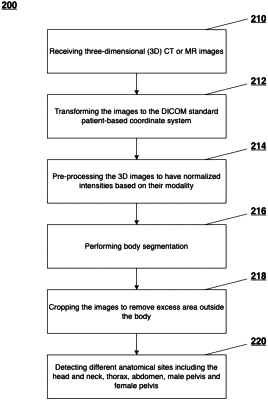| CPC G06V 40/10 (2022.01) [G06V 10/267 (2022.01); G06V 10/273 (2022.01); G06V 10/28 (2022.01); G06V 10/34 (2022.01); G06V 10/457 (2022.01); G16H 30/20 (2018.01); G16H 30/40 (2018.01); G06V 2201/031 (2022.01)] | 17 Claims |

|
1. A computer-implemented method for the automatic detection of anatomical sites using one or more processors, the method comprising:
receive 3D images obtained by a CT or an MRI system;
transform the received 3D images to the DICOM standard patient-based coordinate system;
pre-process the transformed images to normalize intensity values based on the received 3D images obtained by the CT or MRI system;
perform image segmentation on the pre-processed transformed images to obtain the body mask;
crop the pre-processed transformed images to remove excess areas outside the segmented body mask;
wherein anatomical sites consisting of head and neck, thorax, abdomen, male pelvis and female pelvis;
wherein the step of detecting the anatomical sites comprises:
create an empty list;
perform slice-level analyses on 2D axial slices of the pre-processed transformed images to detect the presence of the head and neck region using dimensional measurement thresholds based on human anatomy;
add the head and neck region in the list,
if the head and neck region is present;
perform image segmentation on the pre-processed transformed images to obtain lung mask;
calculate lung ratios on the 2D axial slices to determine if the lung mask are present in the axial slices;
determine whether the pre-processed transformed images with lung mask present includes at least one of the thoracic region, abdomen region or at least one of the combination thereof;
verify presence of neck region to determine the presence of thoracic region or the abdomen region;
determine the presence of both the thoracic region and the abdomen region,
if the thoracic region is present and the field-of-view of the pre-processed transformed images in the axial direction is large enough to cover both the thoracic and abdomen regions;
add the thoracic region or the abdomen region or both in the list,
if the thoracic region or the abdomen region or both are present;
determine the presence of pelvis region on the pre-processed transformed images with lung mask present;
determine the presence of pelvis region on the pre-processed transformed images with no lung mask present by conducting 2D connectivity analysis on the 2D axial slices;
differentiate detected pelvis region as either male pelvis or female pelvis region based on human anatomy;
add male pelvis or female pelvis region in the list,
if the pelvis region is present; and
output the list of all the detected anatomical sites.
|